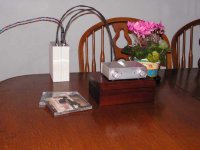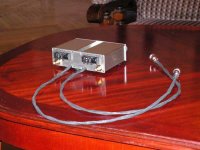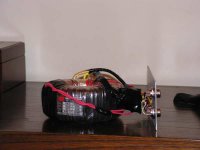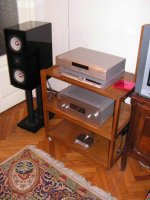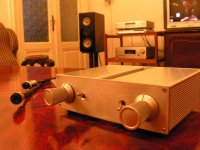It is not a Rolex (or Patek) but just a simple Seamaster…
If you have read the story about the Rolex and the Patek you’d probably understand why I called my GC simply “Seamaster” (you know - the Omega quartz watch). The differences between the Rolex and the Seamaster are huge (the last one is times cheaper and not so pretentious). So are the differences between the Gain Card (or Patek) and the amp I built. But it’s still a “watch” as far as it was totally hand made, and it is smaller than the Gain Card, and was very difficult to build.
I didn’t intend to make a Gainclone initially. I made some not-successful attempts 2 years ago. My plans were (and still are) to build an Aleph 30 and I have all the parts, heat sinks, everything, but no time… I build the Seamaster by chance because I saw those small cases (heat sinks) that look like the ones of the original Gain Card in a store and I bought them. After that they operated on me and staying at home I had a lot of time to build something small and not too heavy as a GC.
I tried to make it as close looking to the 47 Labs amp as possible. Firstly because I like traditions, secondly because I don’t think that newer things that appear are mandatory better then the old stuff, and thirdly because the original Gain Card deserves at leas this respect of the DIYer – to never forget how everything has started. That’s why I have chosen to use only one single bridge and no caps in the PSU, a 12 position attenuator, a switch for the speaker cable, etc. Even the speaker terminals (as an idea) are closer to the original Gain Card than to the other GCs or amps in general. The differences are: it is 15 cm wide only (the original is 17 cm). The cabling is based on phone cables – up to 4x26 and 24 AWG single strand wires (except the input wire).
The PSU consists of a 300VA toroidal transformer, a bridge rectifier (4xMUR860 ON Semi), and a small separate circuitry and windings for the led. What is strange is that there is a third cable near the primary cables. It should go to the core. I connected it to ground. It works fine, without hum and buzz, and without getting hot. There is no switch on the PSU. The amp is tot meant to be turned-off but only unplugged when not used for a longer period of time.
The amp runs cold. When not playing music one can hardly feel the heat it dissipates. When I listen to normal listening levels it worms-up a bit – up to 35 grades C (at room temperature of circa 25 grades).
I find the 12 position attenuator and the mute switch very useful. Actually I rarely use more than 3 positions in the middle.
Here it is…
If you have read the story about the Rolex and the Patek you’d probably understand why I called my GC simply “Seamaster” (you know - the Omega quartz watch). The differences between the Rolex and the Seamaster are huge (the last one is times cheaper and not so pretentious). So are the differences between the Gain Card (or Patek) and the amp I built. But it’s still a “watch” as far as it was totally hand made, and it is smaller than the Gain Card, and was very difficult to build.
I didn’t intend to make a Gainclone initially. I made some not-successful attempts 2 years ago. My plans were (and still are) to build an Aleph 30 and I have all the parts, heat sinks, everything, but no time… I build the Seamaster by chance because I saw those small cases (heat sinks) that look like the ones of the original Gain Card in a store and I bought them. After that they operated on me and staying at home I had a lot of time to build something small and not too heavy as a GC.
I tried to make it as close looking to the 47 Labs amp as possible. Firstly because I like traditions, secondly because I don’t think that newer things that appear are mandatory better then the old stuff, and thirdly because the original Gain Card deserves at leas this respect of the DIYer – to never forget how everything has started. That’s why I have chosen to use only one single bridge and no caps in the PSU, a 12 position attenuator, a switch for the speaker cable, etc. Even the speaker terminals (as an idea) are closer to the original Gain Card than to the other GCs or amps in general. The differences are: it is 15 cm wide only (the original is 17 cm). The cabling is based on phone cables – up to 4x26 and 24 AWG single strand wires (except the input wire).
The PSU consists of a 300VA toroidal transformer, a bridge rectifier (4xMUR860 ON Semi), and a small separate circuitry and windings for the led. What is strange is that there is a third cable near the primary cables. It should go to the core. I connected it to ground. It works fine, without hum and buzz, and without getting hot. There is no switch on the PSU. The amp is tot meant to be turned-off but only unplugged when not used for a longer period of time.
The amp runs cold. When not playing music one can hardly feel the heat it dissipates. When I listen to normal listening levels it worms-up a bit – up to 35 grades C (at room temperature of circa 25 grades).
I find the 12 position attenuator and the mute switch very useful. Actually I rarely use more than 3 positions in the middle.
Here it is…
Attachments
The sound…
It sounds surprisingly good. Even with my Odin loudspeakers and load impedance that drops down to 3 Ohms. The amp I’ve been using for the last 5-6 years is a SE 10W JLH with 35 MHz Toshiba drivers. Both amps have strong and let us say not so strong points (I won’t use the word “weak”, because there are no weak points). Both are very, very good. The tonal balance is similar. There are differences of course. I’d say they are of the same league. It took 10 days or so for the Seamaster to brake-in.
Here you can see how little it is near to some other stuff.
It sounds surprisingly good. Even with my Odin loudspeakers and load impedance that drops down to 3 Ohms. The amp I’ve been using for the last 5-6 years is a SE 10W JLH with 35 MHz Toshiba drivers. Both amps have strong and let us say not so strong points (I won’t use the word “weak”, because there are no weak points). Both are very, very good. The tonal balance is similar. There are differences of course. I’d say they are of the same league. It took 10 days or so for the Seamaster to brake-in.
Here you can see how little it is near to some other stuff.
Attachments
- Status
- This old topic is closed. If you want to reopen this topic, contact a moderator using the "Report Post" button.
- Home
- Amplifiers
- Chip Amps
- “Seamaster” GC
